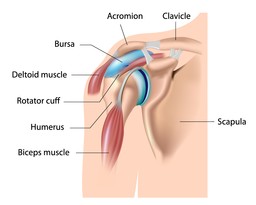

What is the shoulder?
The shoulder is made of three bones and two joints. The bones include the upper arm bone (humerus), shoulder blade (scapula), and collarbone (clavicle). The joints are made up of the ball and socket joint (glenohumeral joint) and the AC (acromiclavicular) joint where the clavicle and scapula articulate.

The head of the upper arm bone fits into a rounded socket in the shoulder blade. This socket is called the glenoid. A combination of muscles and tendons help to keep your arm in this socket. These tissues are called the rotator cuff. They cover the head of the upper arm bone and attach it to the shoulder blade. There are several other muscles that are responsible for coordinated movement of the shoulder blade and neck which have an impact on moving your arm properly.
What causes shoulder pain?
There are four major categories for shoulder pain. These categories include arthritis, instability, trauma (i.e. fracture, muscle strain), and tendon inflammation.
Types of shoulder problems:
Tendonitis: A tendon is a cord that connects a muscle to a bone. Tendonitis occurs when the tendon is inflamed or irritated, typically as a result of overuse. This will typically get progressively worse with continued overhead use.
Tendon Tears: Tendon tears occur from trauma as well as repetitive wear and tear which will degrade the quality of the tendon tissue and eventually result in the tendon tearing, partially or fully.
Impingement: Impingement occurs when the shoulder blade puts pressure on or “pinches” the underlying soft tissue when the arm is lifted away from the body.
Instability: Shoulder instability can occur when the upper bone is forced out of the shoulder socket partially (subluxed) or fully dislocated.
Arthritis: Pain can be caused as a result of arthritis. Osteoarthritis is a common type of arthritis in which cartilage has decreased on the joint surface causing bones to rub together.
Fractures: Broken bones are fractures. Factures are often seen in older patients as a result of a fall. In a younger patient, shoulder fractures can be caused as a result of a high fall or sports related injury.
Examination and Diagnosis:
History and physical exam by a qualified musculoskeletal expert is the first step. X-ray or MRI scanning may be required depending on the mechanism of injury and symptoms. Examination of the shoulder will typically include palpation, observation, testing range of motion, strength, and muscle length. In addition various provocative tests may be used to target a particular structure. These will guide a clinician toward a proper diagnosis.
Treatment Options:
Activity changes and exercises, including physical therapy, can help to improve shoulder strength, flexibility, and range of motion. Medications could be prescribed to help reduce pain and inflammation. Injections or numbing medicines may also be recommended for certain diagnoses.
Surgery may be indicated to resolve some shoulder problems. Surgery procedures include arthroscopic surgery to repair torn tissues or open procedures for larger reconstruction. Other traditional shoulder procedures include reconstruction or shoulder replacement.
Copyright © www.orthopaedics.win Bone Health All Rights Reserved